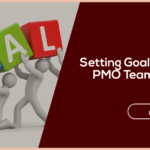A new project management office (PMO) needs a solid foundation to make it successful right out of the gate. There are plenty of pitfalls your new PMO can face defining and setting goals for your office is one way to avoid them.
Creating a new PMO can be a great career achievement, and getting it right can set up you and the organisation you work in for success in years to come. Getting it right at the beginning and avoiding common pitfalls of PMO creation is going to help your office survive and thrive.
We’re going to get into the details about setting goals for your PMO, including:
- How unclear goals can set your PMO off on the wrong foot
- What you can do in the planning phases to define your PMO goals
- Following through on your PMO goals to ensure your PMO becomes sustainable
The problem of unclear PMO goals when creating a new office
Being given the green light to get your PMO established is a great achievement in and of itself. However, this is where the major challenge begins, and the road ahead can be tough.
Having goals gives your PMO a direction to head in and an idea of why it’s there to begin with. Even if you start as a small office with a couple of team members, you need to make sure everyone knows what they’re there for.
Unclear PMO goals can lead to people focussing on the wrong tasks. When setting priorities for your projects, you need to make sure these align with what your PMO needs to achieve – without goals, these priorities can become skewed.
The end game of a PMO without clearly defined goals can be the closure of the office. It’s a common adage within PMOs that they have a short shelf-life, and without goals, it can be hard to prove your office’s value down the road.
How to set clear goals for your PMO
Your PMO goals should be one of the first things you deal with when setting up your PMO. These goals will guide your decisions about things like the services you will offer and the roles you will hire for.
Here are five steps to setting clear goals that will guide your PMO to long-term success:
- Understand the wider company objectives. Your PMO needs to align with what the business wants to deliver to make sure that it is relevant and that you can plugin your achievements to the business plan. Consider if the business has environmental, social, and governance goals and how these can fit into your work, for example.
- Bring in stakeholders early. The stakeholders in your PMO, such as your sponsor, project managers, and clients, should all be part of the discussion about what your office should achieve. Since stakeholder buy-in is another area you need to work on when setting up a PMO, this is an important step.
- Make your goals SMART. You’ll already know about SMART targets when setting goals and KPIs for the people you lead and you should do this for your PMO as well. Make your goals specific, measurable, achievable, relevant, and time-bound so you can track progress in a clear and consistent way.
- Review and adjust your goals. With your goals set, you need to have the flexibility to adapt them as your PMO and the wider organisation change. For example, in the current climate of budget cuts, you need to make sure your goals can still be met with fewer resources on hand.
- Have clear communication of goals. Everyone in your PMO should know what they are working towards and how it fits into the business’ bigger picture. Project managers should also be aware of their goals that report into your office so they understand what is expected as they work through their tasks.
The pitfall of unclear PMO goals
Your PMO needs to know what its purpose is from the very beginning. This will help you know what the office is going to do and the skills you need to get it done. Defining and setting clear PMO goals will avoid this common PMO pitfall.






